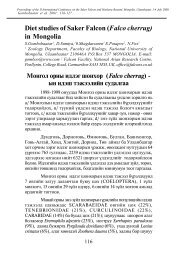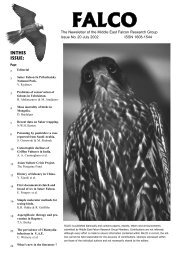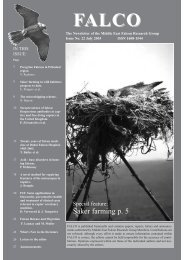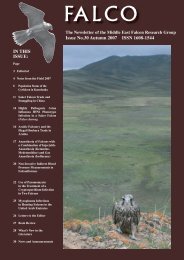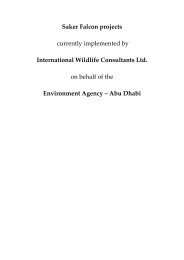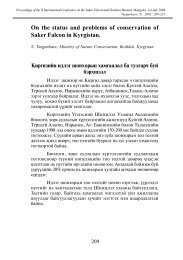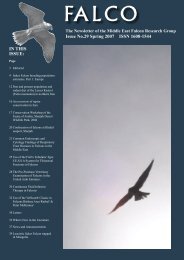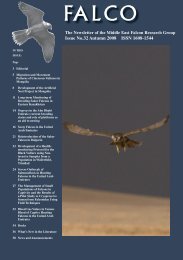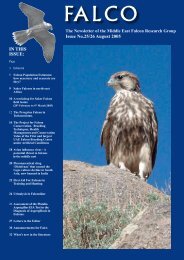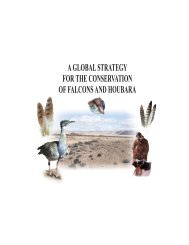Falco 27 - International Wildlife Consultants Ltd.
Falco 27 - International Wildlife Consultants Ltd.
Falco 27 - International Wildlife Consultants Ltd.
- No tags were found...
You also want an ePaper? Increase the reach of your titles
YUMPU automatically turns print PDFs into web optimized ePapers that Google loves.
Punjab were conducted in November 2000. Populationwas estimated about 4,729 birds with overall density of0.150 ± 0.007 ind./km2. In Rajanpur 426, in Thal 662and in Cholistan 3,644 Houbara were estimated. Sanddunes and vegetation cover were identified as importantfactor to make precise and accurate estimates, assumingrandom distribution of sand dunes (P = 1.0), the visibilityof each transect under study was variable. With increasein sand dunes and vegetation cover the probabilityof sighting Houbara was decreased. [English].Key words: Houbara Bustard, Chlamydotisundulata, Pakistan, wintering, number, conservation.Address: M.S. Nadeem, Biochemistry Department,Hazara University, Mansehra, NWFP, Pakistan. e-mail:sajid_nm2003@yahoo.co.uk.Raptors, tradition and powerlines in southernCentral Asia.Orden C. van & Paklina N.V. De Takkeling 9. 2001.2<strong>27</strong>-234.During visits to eastern Kazakhstan, the abundant useof feathers of owls, mostly Eagle Owls Bubo bubo,was found to be characteristic of the region. Tuftsof feathers are placed in strategic places, such asbedrooms and cradles, or are used as an amulet. Hats,caps and bonnets worn during festivals and ceremonialgatherings were adorned with tufts of (eagle) owlfeathers taken from breast and mantle. In the absenceof owl feathers, feathers of birds of prey were used. Thefeathers are thought to be reincarnations of guardianspirits with sacred powers. The massive use of suchfeathers resulted in widespread elimination of EagleOwls in large parts of Kazakhstan. However, in recentyears the local tribes explore the antiquated powerlines,where large numbers of birds of prey and owls are beingelectrocuted, thus providing easy access to feathersused for ornamentation. In the village of Orlovka,eastern Kazakhstan, the chief showed a collection of14 Steppe Eagles Aquila nipalensis, 4 Imperial EaglesA. heliaca, 3 Golden Eagles A. chrysaetos, 6 SteppeBuzzards Buteo buteo vulpinus, 5 Upland BuzzardsB. hemilasius, 2 Saker <strong>Falco</strong>ns <strong>Falco</strong> cherrug and 4Eagle Owls Bubo bubo, all found beneath powerlinesbetween Orlovka and Ust-Kamenogorsk. This selectionis just the tip of the iceberg, because similar powerlinesare in use all over southern Central Asia. Electrocutedbirds are nowadays the main source of feathers used fortraditional wear and amulets.Contact: C. van O: Doelenstraat 14, 1601 GL Enkhuizen.Email: paklina@planet.nl; N. P.: Institute of AnimalEcology, Russian Academy of Sciences, Aviamotoraia15, kv 2, 111020 Moscow, Russia. Email: paklina@hotmail.com.Anatomical and Clinical Radiology of Birdsof Prey: including interactive advancedanatomical imaging.Jaime Samour MVZ, PhD, Dipl ECAMS and JesusNaldo DVM.Elsevier <strong>Ltd</strong>, Oxford, UK. Date of publication August2006. Price GBP 85.00.Anatomical and Clinical Radiology of Birds of Preyis a comprehensive atlas of the normal radiographicanatomy of raptors including the saker falcon, gyrfalcon, common barn owl, Eurasian eagle owl, northerngoshawk, red kite, Eurasian honey buzzard, palm nutvulture and steppe eagle.Anatomical and Clinical Radiology of Birds of Preyalso describes the clinical and pathological conditionsthat are commonly encountered in birds of prey. Whatmakes this atlas unique is that a coloured photographof a particular clinical condition (e.g., bumblefoot) or aphotograph taken during a post-mortem examination ispresented together with the radiograph.Radiographic procedures such as positioningtechniques, contrast radiography and magnificationradiography are also presented in this atlas. Anatomicaland Clinical Radiology of Birds of Prey also containsa chapter on advanced clinical anatomy imaging thatinclude ultrasonography, computed axial tomographyand magnetic resonance imaging. This chapter and therelated interactive DVD enclosed in this book aim tobe learning tools for those who want to acquire a basicknowledge of veterinary digital imaging in the field ofavian medicine.26



